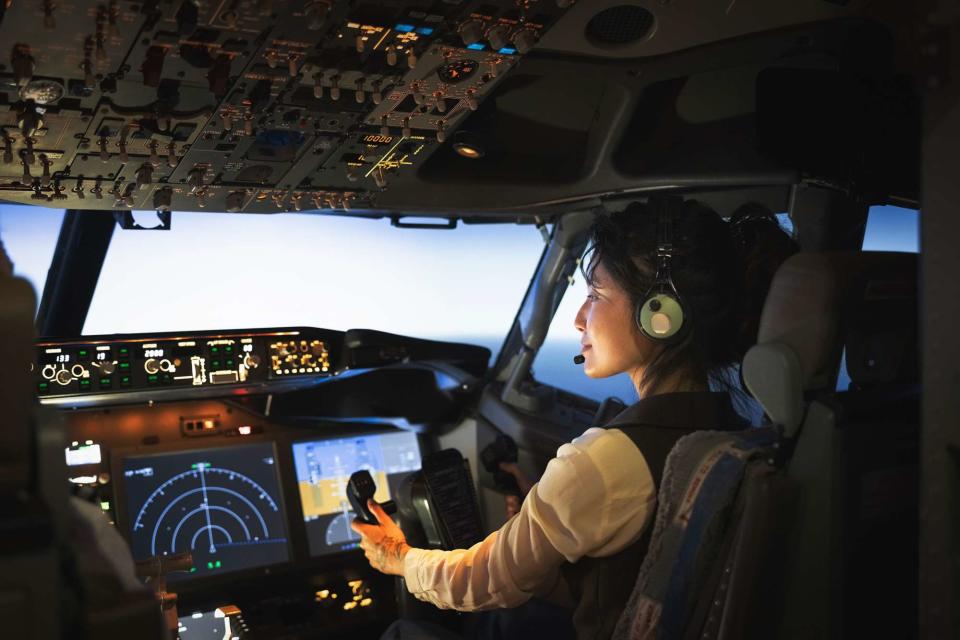Why You Should Start Every Flight With This Pilot-approved 5-second Safety Tip
Plus, more safety tips you should follow.

Portra/Getty Images
While air travel is undoubtedly one of the safest forms of transportation, you should always be mindful of your safety onboard, just in case there's an emergency. We asked pilots to share what steps they take as passengers to ensure they're prepared for an emergency, and they unanimously agreed on one tip: locate the emergency exit nearest you.
"As soon as I board a plane, I always take note of the nearest emergency exit, counting the number of seat rows between my location and that exit," says former pilot Hans Mast, now a travel agent with Golden Rule Travel. Counting the rows might be a part of the process that's overlooked by some travelers, but it's an especially important step to take. "In the event of an emergency, visibility could be impaired, and having this mental map can be life-saving," he adds. Remember that if the interior of the cabin is filled with smoke, you can look for colored lights along the aisle to indicate where the exits are.
Related: 25 Things You Should Do Before Boarding a Plane, According to a Frequent Flier
And don't wait until the plane is ready to take off to locate your nearest emergency exit — do it right as you board. "Awareness of your safety on an aircraft starts the moment you enter the aircraft, not once the cabin crew starts the safety briefing. The pilots may press the evacuation alarm even before the engines are started," says former pilot Nick Eades. "As the captain of a 747, I had to complete a rapid evacuation of the passengers when an air conditioning truck attached to the aircraft caught fire. Out of 400 passengers, only a handful reacted quickly enough. Had the fire taken hold, the outcome could have been catastrophic."
Along those lines, it's a good idea to book seats in the exit row if you're willing and able to aid in an emergency. Per a 2008 study by the University of Greenwich, passengers closest to an exit row are more likely to survive a plane crash, as they're typically able to evacuate the plane faster than those farther from an exit. Just remember that while the exit row usually comes with the perk of extra legroom, it's crucial that you're physically able to open the emergency exit. (And never take your bag with you in an emergency, as that can hold up the evacuation and lead to more injuries or deaths.)
Beyond choosing a seat near an exit and knowing exactly where the nearest exit is, there are plenty of other ways you can prepare yourself for a potential emergency. And the prep work should begin before you leave for the airport.
"I do not overstuff my carry-on bag," says former pilot Dan Bubb, a professor at the University of Nevada, Las Vegas. "I've seen many passengers bring very large and heavy carry-on bags onboard the plane and try to unsuccessfully stuff them into the overhead bins. This not only is time-consuming and prevents other passengers from getting to their seats, but extremely dangerous should those bags fall on someone."
Bubb also recommends wearing closed-toe shoes to prevent any injuries, whether that's stubbing your toe as you walk down the aisle to the lavatory or injuring your feet during an emergency evacuation — you never know if there might be sharp metal protruding from the plane.
Related: Why Planes Are Among the Safest Modes of Transportation, According to Aviation Experts
Once you're onboard, you should pay attention to the safety briefing on the video screen or performed by the flight attendants, no matter how frequently you fly. "Even though I am thoroughly familiar with the flight attendants' safety demonstration, I still pay attention to each one," says Bubb.
On the same note, you should also peruse the safety card in the seat-back pocket. Even if you're an expert flyer, each type of aircraft has different layouts, locations of emergency exits, and methods of opening emergency exits. Refresh your knowledge to make sure all the safety protocols for the specific aircraft you're on are at the top of your mind.
Overall, the likelihood that you'll be in a plane crash is very low. And even if you are in one, the odds of survival are very high. A study by the National Transportation Security Board determined that between 2001 and 2017, 98.2 percent of passengers in aviation accidents involving U.S. carriers survived with little or no injuries. Still, it's always a good idea to be prepared to keep your chance of survival as high as possible.
For more Travel & Leisure news, make sure to sign up for our newsletter!
Read the original article on Travel & Leisure.


